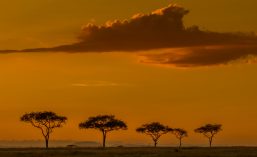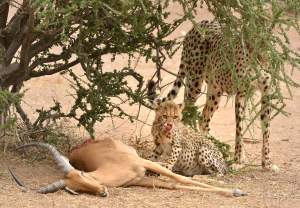Mashatu is a place of great contrasts. The seasons colour and coat this place in very different livery. Late winter and early spring, before the rains, can be hard, especially for the herbivores. Even the Impala browse in early spring because their is almost nothing to graze on. The Elephant can be seen at river bends digging for water. The water table is usually not too deep. The predators have the best time of it in winter and early spring. This spring was no exception, but the game generally looked to be in much better condition than last year, around the same time.
Though we travel the world over to find the beautiful, we must carry it with us or we find it not.
Ralph Waldo Emerson
Many predators large and small can be seen in Mashatu. Some are hunters and some scavengers. When the primary predators such as Lion and Leopard are busy, the scavengers have a much easier time of it. One predator which is highly adaptable is the Black Backed Jackal. We saw many of these Jackal during our last visit. Often we would see a solitary animal lying in the shade, if it was vey hot, or foraging in the early morning or early evening. This character was lying in the shade as the afternoon sun was fierce.
We were in Mashatu Game Reserve for four days in early October. The first two were hot. On the second day, the temperature was 37 degrees centigrade in the shade at 15h30. Two days later we had to wear jackets all day because it was so cold – but that is the bush for you. The coldest I have ever been was when a small group of us were caught in a thunderstorm on side of the mountain just above Injasuti in the Drakensberg Mountains. By six in the evening it was absolutely pitch black and we could not see our way making it too dangerous to proceed. We could not get back to camp so had to spend the night in the pouring rain on the side of the mountain about half a kilometre from the camp. Although this took place in mid-November, it was the coldest I have ever been..
‘You can flirt with mother nature but don’t ever think she is your chick’
These words will ring in you ears if you don’t respect the bush.
Back to Mashatu, on the same afternoon we saw the Black Backed Jackal, we found a pride of Lions and this Lioness was wisely lying in the shade. It was late afternoon but still very hot. Of course most of the predator action takes place in the hours of darkness when you are telling tall stories around the camp fire about your wildlife encounters. The two predators you will hear most often at night are ‘whooping’ of the Hyaena and high pitched yapping of the Jackal. You might be lucky to hear a Lion roaring at night or even a Leopard coughing in the early morning or late afternoon. Hearing these large predators at night stirs a deep primal reaction in us.
The second hot afternoon, we found two Hyaena mothers lying in the sand at around 17h00. It was still very hot and they were panting heavily while their youngsters suckled. One thing I found interesting was both mothers licked their forelegs and then rubbed their faces on their forelegs. This way they wet their faces so that any passing breeze would provide some cooling relief.
Considering how aggressive these predators can be in the hunt or when trying to push a Lion or Leopard off a kill, it is fascinating to see how incredibly gentle they are with their cubs.
Hyaenas are intriguing predators mainly because their behavior can appear strange, hideous, bizarre and downright peculiar to us.
One morning around 9h00, we came across a Lioness and her cub feeding on an Eland carcass. They had lots of company. There were four Black Backed Jackals hanging around out of harms way and a pair of Tawny Eagles who had decided it was worth the wait. It is one thing to see the Lioness stripping flesh off the bones but it is not until you hear and see a Lion crushing bone that you realize how strong their jaws are. This Lioness was feeding for about 45 minutes before she decided it was getting too hot and dragged the remains of the Eland carcass in to the shade of a nearby bush.
This Lioness must have dragged this Eland carcass about thirty metres in the blazing sun with her one year old cub hanging on and playing with its moving meal. This was one really strong female.
A short while later, the same cub popped out of the bushes to have a look in the direction of an interesting sound. You can see by the size of his paws, he has a lot of growing still to do.
We were also fortunate enough to see a female Cheetah and her remaining cub. We understand there had been three cubs but two were killed some time before. We saw these Cheetah just south east of Pole Hill late one afternoon in an open area ideal for hunting. Something must have spooked this youngster because he was very nervous, constantly looking behind him as we was walking along with his mother.
Looking at the fragility of this Cheetah cub you realize what an incredible task it must be for this mother Cheetah to bring up her cub amongst Lion, Hyaena, Leopard and Jackals. All of which would not hesitate to kill the cub.
The next morning, we found the Cheetahs in the same area we left them the evening before. The Cheetah mother had killed a Impala earlier that morning judging from how little had been eaten. The Impala had been dragged under what looked to be a Monkey Puzzle bush. When we first arrived the mother lay some distance away from the cub. Cheetah use this tactic so that all the family members are not compromised at the same time. Both mother and cub were on high alert, but the mother kept watch while her cub tucked in. The cub was still very skittish and kept looking around after every few mouth fulls.
The wind was blowing and this is when most animals in the bush are on high alert. The wind muffles sound and disperses scent so their normal senses are compromised. Eventually, the Cheetah mother walked around the bush to make sure nothing was lurking which she did not know about. This Cheetah mother had a tracking collar so was obviously part of a Cheetah research project.
As I mentioned earlier, on our last afternoon, the wind was blowing quite hard and it was cold. This Black Backed Jackal was tucked up in a tight ball, dozing.. They never seem to fall asleep. Nose tucked under his bushy tail, he seemed well insulated from the cold. It is also interesting to see this Jackal was lying in a thick bed of leaves, which must have given him warmth and camouflage.
On our last evening down next to the Majali River close to where the White-Fronted Bee-Eaters had their nesting colony last year, we came across this forlorn Hyaena. This poor animal had been mauled. Probably not by a lion but more likely by other Hyaenas. It had lost both ears, possibly in a skirmish with other Hyaenas and its had lost the lower part of its left hind leg.
The incredible thing about this Hyaena was that as mauled as it was and in obvious pain it had not given up. It was thin but did not look to be badly mal-nourished. Despite its desperate state, this character was not about to give up.
Nature offers many paradoxes. It is very unlikely that you see the same thing in the same place the next day, be it a bird or an animal. I cannot count how many days I have spent in the bush and I am constantly surprised by new behavior, unusual interactions, new scenes and the ongoing newness and learning in it all.
We should not pretend to understand the world only by the intellect. The judgment of the intellect is only part of the truth.
Carl Jung
Seek to understand nature, marvel at its interconnectedness and then let it be.
Have fun
Mike




















Nice read, it brings me right back to wonderful Mashatu! And it is interesting to see how strong the will to live is in that injured hyena – it was already in that state when we were there end of august! They are really amazing animals!!!